If you’re a marketer, you’re in the memory-making business.
(Whether you realize it or not.)
Because even the most brilliant brands, products, apps, and campaigns will fail if they’re forgettable.
Brilliant, but Forgettable
Do you remember the last time you bought a new product? Imagine you’ve snagged a face serum after it went viral on TikTok.
The serum promised fantastic results, but only if you used it every night. You were really excited to see your skin transform, so you used the serum every night… for a few days.
Then your old skincare habits took over. You stashed the fancy serum in the back of your bathroom cabinet and forgot all about it.
Turns out that the number one reason new products fail in the long run is that people just forget to use them.
We don’t try these products and hate them, and we have every intention of continuing to use them. We just… forget.
So how can marketing and experience design create memories that help your brand grow, sell more products, and get people to use them?
Here’s what behavioral science, psychology, and neuromarketing suggest.
How a Brand C.R.E.A.T.E.S. Memories
If you want to be unforgettable, follow these seven principles:
C: Consistency
R: Repetition
E: Emotion
A: Attention
T: Time & Frequency
E: Experience
S: Storytelling
1. Consistency
If you want someone to remember your brand, don’t change the logo, the packaging, the brand colors, or even the spokesperson for a while.
And by “a while” I mean years.
Sound extreme? Here’s how one of the world’s most successful brands used consistency to make itself memorable:
How Coca-Cola Applies Consistency
Coca-Cola is one of the most consistent brands in history — its logo and bottle have barely changed in 100+ years.

That’s why it’s been the world’s best-known brand for nearly as long. According to an internal study done in the 1980s, “Coke” is the second most understood word in the world after “okay.”
When you keep these elements, called brand assets, consistent for years they start to work a groove into peoples’ brains. Customers can’t help but remember your brand when they’ve seen the same logo millions of times. And the better your brand is remembered, the more likely people are to buy it.
The better your brand is remembered, the more likely people will be to buy it when they’re ready.
🚀 Learn what makes buyers tick
Join 8k+ of world's best marketers from brands like Disney, Coca-Cola, Google who are learning marketing psychology in <5 mins a week.
2. Repetition
If you want people to remember your brand and what it sells, you can’t just tell them once.
You can’t tell them twice.
You have to tell them thousands of times.
Consistency and repetition go hand-in-hand. When you show someone the same logo thousands of times over the span of 20 years, it’s easy to remember. But if you show a customer 10 different logos in 20 years, it’s nearly impossible to create memories, because to the customer, the brand is always changing.
It’s why brands like Coca-Cola spend more than $4B a year on advertising that puts those brand assets on display (without talking about price or product features). The more you want someone to remember something, the more you have to repeat it.
How Coca-Cola Applies Repetition
One of the best examples of repetition in Coke’s advertising are its “Holidays are Coming” ads, which first ran in 1995.
The original “Holidays are Coming” Coke ad featuring the “Always the Real Thing” jingle:
The updated “Holidays are Coming” ad (with a reworked song):
Now people wait for these ads to feel that the holiday season has begun — but you can bet they wouldn’t if Coca-Cola had only run the ads for one or two years.

3. Emotion
Want people to remember your brand and its products? Make them emotional. Studies tell us that emotion is like superglue — it makes information stickier and more likely to be remembered.
Deloitte Digital even found that these positive emotional experiences drive business results:
- 92% of customers are more likely to stay loyal to a brand with which they have a positive emotional connection.
- 88% of customers are more likely to spend more with brands about which they feel positively.
- 91% of customers are willing to advocate for businesses with which they associate positive emotions.
How Coca-Cola Applies Emotion
Coca-Cola, famously, “owns happiness.” It’s spent billions of dollars associating the brand with the feeling of being happy. Its taglines have traded on happiness, emotions, and “feelings” for years:
- 1979: Have a Coke and Smile.
- 1989: Can’t Beat the Feeling.
- 2001: Life Tastes Good.
- 2009: Open Happiness.
- 2011: Life Begins Here.
- 2016: Taste the Feeling.
Cola-Cola doesn’t just talk “happy.” Its ads show happiness, too:
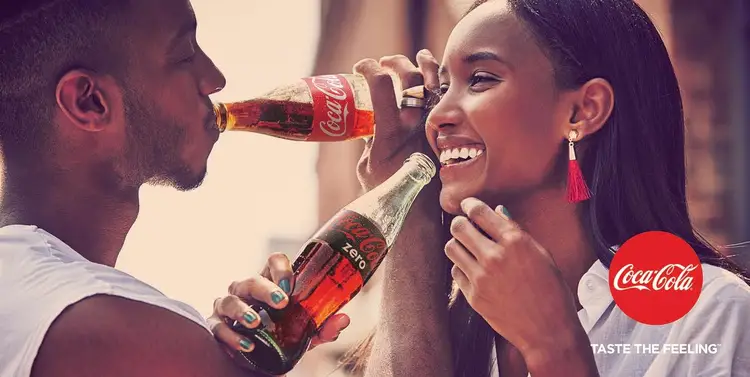
Many Coke ads feature smiling people enjoying Coca-Cola products while doing something that makes them happy: on a date, dancing, or spending a day on the beach.
But they don’t just talk and show happiness. Coca-Cola wants people to experience happiness too — through its experiential marketing like the world’s first vending machine that exchanged hugs for bottles of Coke.
4. Attention
Marketing can’t create memories if everyone ignores your marketing, right? So grabbing attention is a key part of creating memories. And while emotions and storytelling can capture peoples’ attention, making sure our messages are salient and simple is critical as well.
Salience Bias describes our attraction to things that are “easy” for our eyes to notice. And thankfully we have tools that can help us figure out if a message is salient (see below for examples of salience analysis).
How Coca-Cola Grabs Our Attention
Coke’s brand colors — red and white — are attention-grabbing due to their high contrast and brightness. Display those colors against busy backgrounds, like London’s Piccadilly Circus or Times Square in New York, and you can spot them a mile away.
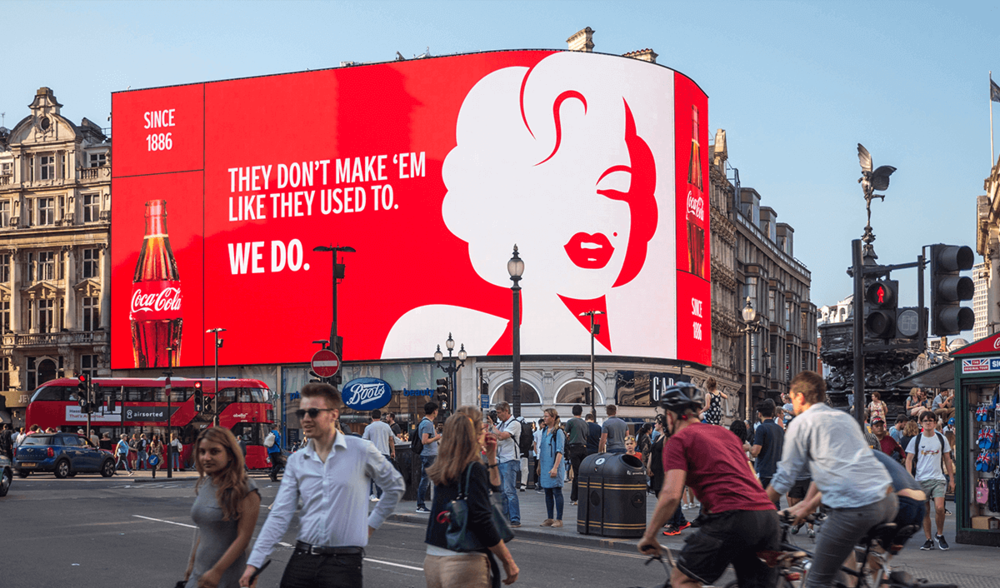
As you can see from the salience analysis below, our eyes can’t help but be drawn to Coke’s attention-grabbing ads, even in the middle of the most crowded spot in New York City.
Note: The red squares with numbers on the grid indicate the most attention-grabbing areas of this image.
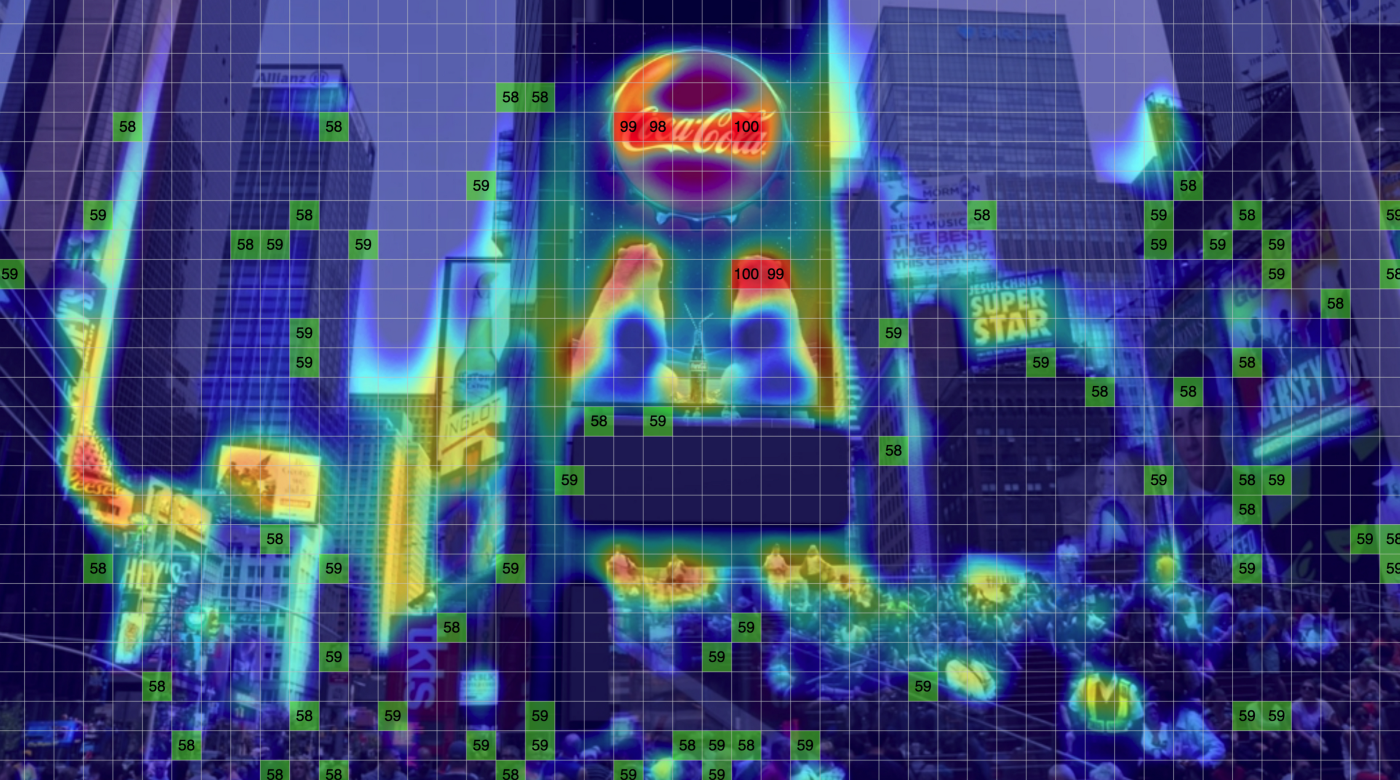
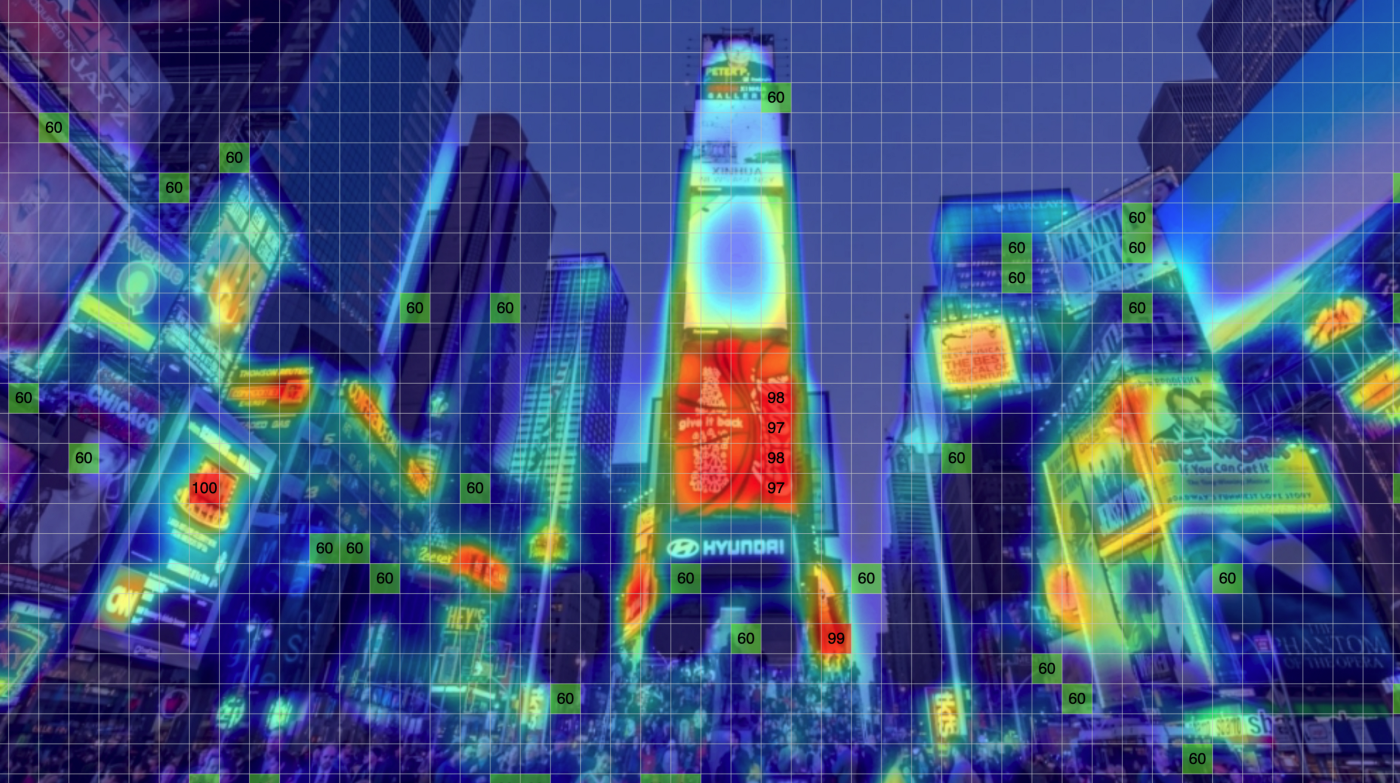
But the brand’s salience isn’t just down to its colors. The simplicity of Coca-Cola’s marketing also makes it stand out. They aren’t trying to say too much in any one ad, and they never water them down with clutter that distracts customers.
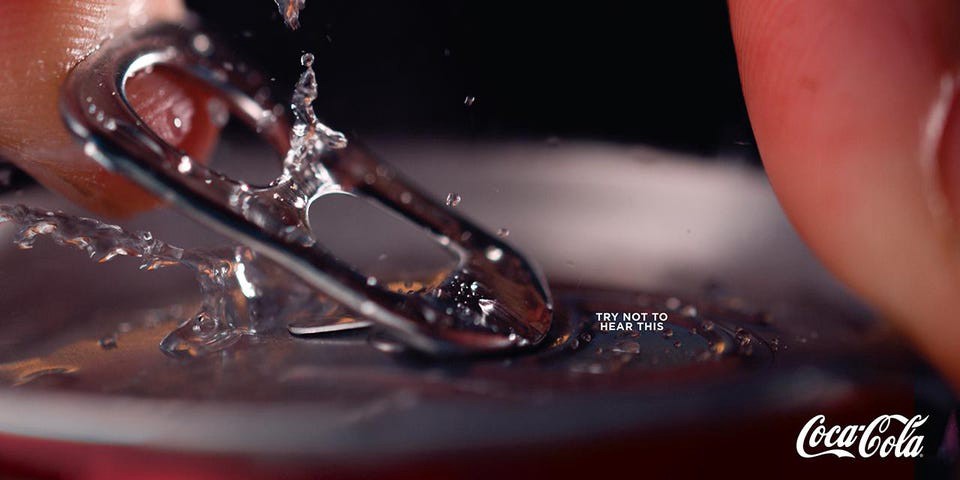
5. Time & Frequency
Even if you’re repeating a consistent message, you still need to give these messages time to sink in. Does that mean you should invest all your money in playing the same TV commercial on repeat?
No.
In fact, it’s much more effective to leave some time for customers to digest what they’ve seen (before seeing it again).
The Spacing Effect says a brand is more memorable when it’s seen multiple times, but those views are spread out over time — not one right after the other. A steady drip approach is more effective than a constant barrage of ads or short bursts of activity.
How Coca-Cola Leverages Time & Frequency
Coca-Cola’s large media budget means it can afford to buy lots of marketing across different channels such as TV, sports sponsorships, social media, websites, billboards, and in-store advertising.
The more times a Coke ad is featured in different contexts, the higher the chance people will be exposed to the brand. And the longer the brand advertises in many different contexts, countries, and channels, the more memorable it becomes.
But deep memories of and associations with the brand are only created if customers are exposed to these ads for years. So like Coca-Cola plan for consistent marketing year-round — not short bursts of activity.
6. Experience
If want someone to remember a new concept, “learning by doing” — also called Experiential Learning — is the most effective method. If you want your child to learn addition, for example, having them add physical blocks together instead of abstract numbers can help them better understand the concept.
When we physically experience something, it increases the chances that we’ll absorb and remember the concept.
Experiences are sticky — they become memories much more easily than random information. So it makes sense that customer experiences and experiential marketing are so important to brands like Coca-Cola.
How Coca-Cola Applies Experience
Coca-Cola wants to drive the feeling of happiness with its experiential marketing, and it makes its products and brand assets the stars of the show.
For example, the brand installed a “Happiness Machine” in the middle of a college campus. It dispensed free Cokes, flowers, a pizza, and even a huge submarine sandwich for everyone to share.
In 2014, the brand even tried to bring together India and Pakistan through its use of a “small world” vending machine. They were installed in two cities, Lahore in Pakistan and New Delhi in India.
Coca-Cola wanted people in the two cities, who had experienced decades of political tension, to share a moment of understanding over a free bottle of Coke.
7. Storytelling
Narrative Bias says that people make sense of the world through stories. Our brains have to process a lot of information, so we pay more attention to (and better remember) narratives instead of random information.
That’s why it’s easier to remember the plot of Hamilton than it is to memorize the Constitutional Amendments — our brains remember the story of the musical, but have a harder time stringing together non-narrative information.
How Coca-Cola Uses Storytelling
Coca-Cola thinks carefully about the stories it tells in its marketing. It knows the power that stories have to create memories, so it wants to make sure that the brand and its products feature prominently in these stories. Kate Santore, Director at Coca-Cola, described storytelling at Coca-Cola this way:
“At Coca-Cola, we want to create Coca-Cola stories and not stories by Coca-Cola.
That holds true when our product is a character in the story with a credible role to play.
There are four typical archetypes that we look to: object of desire, embodiment of an attitude, social connector, and functional offering or benefit.”
“Archetype” is just a fancy word for templates or frameworks, and these describe the role that Coke products need to play in its marketing. For example, in the commercial below Coke acts as a “social connector” by bringing together a lifeguard and a swimmer:
Creating Memories: The Bottom Line
Creating memories is a proven way to create value, find customers, and grow market share. It’s down to a marketing principle called mental availability.
It was coined by Professor Byron Sharp, a marketing researcher at the Ehrenberg-Bass Institute in Australia. His theory is that to grow your brand, you need two things:
- Mental availability: Does this brand or product spring to mind when it’s time to buy? Do people recognize it? Do they notice it on the shelf?
- Physical availability: Can I get or find this product easily when I’m in the mood to buy it?
That’s why creating memories is so important for every customer experience. It’s not just about being remembered — it’s about being sought out, recognized, and top of mind when it’s time to buy.
